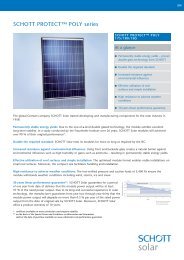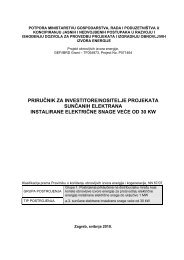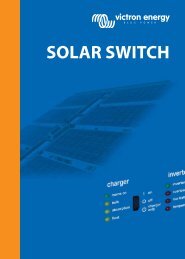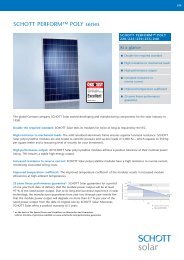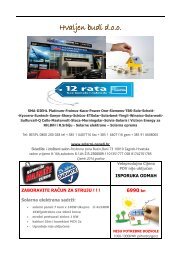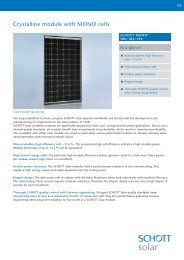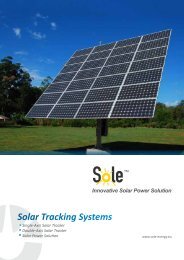Gel and AGM Batteries - Solarni paneli | Sole
Gel and AGM Batteries - Solarni paneli | Sole
Gel and AGM Batteries - Solarni paneli | Sole
You also want an ePaper? Increase the reach of your titles
YUMPU automatically turns print PDFs into web optimized ePapers that Google loves.
www.victronenergy.com<br />
Disadvantages of the traditional 3-step charge characteristic:<br />
• During the bulk phase the current is kept at a constant <strong>and</strong> often high level, even after the gassing<br />
voltage (14,34 V for a 12 V battery) has been exceeded. This can lead to excessive gas pressure in the<br />
battery. Some gas will escape trough the safety valves, reducing service life.<br />
• Thereafter the absorption voltage is applied during a fixed period of time, irrespective of how deep<br />
the battery has been discharged previously. A full absorption period after a shallow discharge will<br />
overcharge the battery, again reducing service life. (a. o. due to accelerated corrosion of the positive<br />
plates)<br />
• Research has shown that battery life can be increased by decreasing float voltage to an even lower<br />
level when the battery is not in use.<br />
11. Battery charging: longer battery life with Victron 4-step adaptive charging<br />
Victron developed the adaptive charge characteristic. The 4-step adaptive chare curve is the result of years of<br />
research <strong>and</strong> testing.<br />
The Victron adaptive charge curve solves the 3 main problems of the 3 step curve:<br />
• Battery Safe mode<br />
In order to prevent excessive gassing, Victron has invented the ‘Battery Safe Mode’. The battery Safe<br />
Mode will limit the rate of voltage increase once the gassing voltage has been reached. Research has<br />
shown that this will reduce internal gassing to a safe level.<br />
• Variable absorption time<br />
Based on the duration of the bulk stage, the charger calculates how long the absorption time should<br />
be in order to fully charge the battery. If the bulk time is short, this means the battery was already<br />
charged <strong>and</strong> the resulting absorption time will also be short, whereas a longer bulk time will also<br />
result in a longer absorption time.<br />
• Storage mode<br />
After completion of the absorption period the battery should be fully charged, <strong>and</strong> the voltage is<br />
lowered to the float or st<strong>and</strong>by level. If no discharge occurs during the next 24 hours, the voltage is<br />
reduced even further <strong>and</strong> the battery goes into storage mode. The lower storage voltage reduces<br />
corrosion of the positive plates.<br />
Once every week the charge voltage is increased to the absorption level for a short period to<br />
compensate for self discharge (Battery Refresh mode).<br />
12. Battery charging in case of st<strong>and</strong>by use: constant voltage float charging<br />
When a battery is not frequently deeply discharged, a 2-step charge curve can be used. During the first phase<br />
the battery is charged with a limited current (the bulk phase). Once a preset voltage has been reached the<br />
battery is kept at that voltage (the float phase).<br />
This charge method is used for starter batteries in vehicles, <strong>and</strong> in uninterruptible power supplies (UPS).<br />
Fig. 4: Four-step adaptive charge curve<br />
13. Optimum charge voltage of Victron VRLA batteries<br />
The recommended charge voltage settings for a 12 V battery are shown in table 3.<br />
14. Effect of temperature on charging voltage<br />
The charge voltage should be reduced with increased temperature. Temperature compensation is required when the<br />
temperature of the battery is expected to be less than 10°C / 50°F or more than 30°C / 85°F during long periods of time.<br />
The recommended temperature compensation for Victron VRLA batteries is -4 mV / Cell (-24 mV /°C for a 12 V battery).<br />
The centre point for temperature compensation is 20°C / 70°F.



